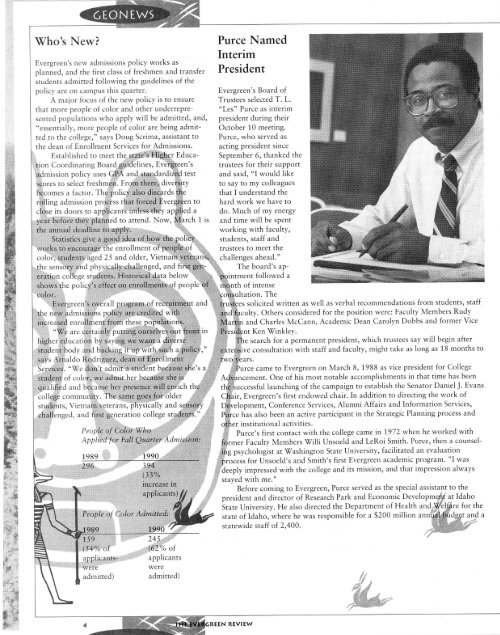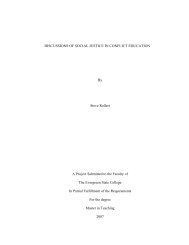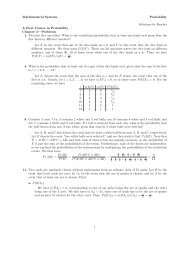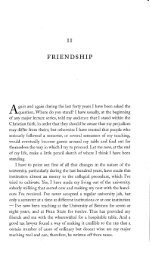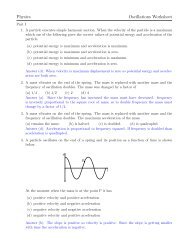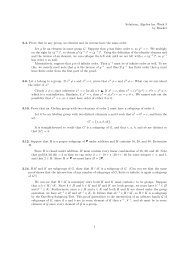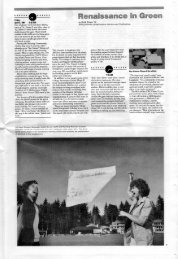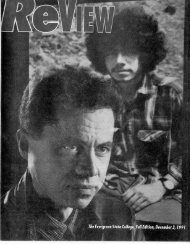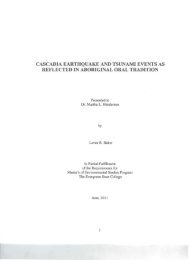V12 #1 November 1990 - Archives - The Evergreen State College
V12 #1 November 1990 - Archives - The Evergreen State College
V12 #1 November 1990 - Archives - The Evergreen State College
Create successful ePaper yourself
Turn your PDF publications into a flip-book with our unique Google optimized e-Paper software.
GEONEW<br />
Greeners Export Environmentalism to U.S.S.R.<br />
by Mike Wark<br />
<strong>The</strong> Volga River, a geographical landmark that cuts across the<br />
Soviet Union, is not really a river. Instead, the Volga is a series of<br />
reservoirs behind seven major dams that are compounding problems<br />
with pollution.<br />
Faculty Member Tom Rainey led a group of faculty and students<br />
to study two Soviet nature preserves on the Volga this<br />
summer. <strong>The</strong>y found that protected areas on the Volga aren't<br />
immune to upriver pollution. However, the Soviet word for nature<br />
preserve means "Forbidden Area," and generally, that description<br />
is accurate.<br />
"<strong>The</strong>re is no hunting and no economic exploitation of forest<br />
lands. <strong>The</strong>y are protected — nature in the raw," says Rainey. "<strong>The</strong><br />
preserves are designed to be ecological models for study, and one<br />
preserve is found in each vegetational zone, or major bioregion,<br />
across the Soviet Union."<br />
Rainey, Faculty Members Oscar Soule and Dave Milne and 10<br />
students were the first Americans ever to set foot on a Soviet nature<br />
preserve to study the environment, according to their host, Marat<br />
Khabibullov of Kazan <strong>State</strong> University. Not even Soviet tourists are<br />
allowed into the areas. <strong>The</strong>y are, literally, forbidden areas, except<br />
for study.<br />
However, a major threat to the preserves are the "marauding<br />
Soviet economic ministries," operating out of Moscow with little<br />
control from the center, says Rainey. Worse than American<br />
corporations that are checked by protectionist forces, the Soviet<br />
ministries have little to stop them when they set sights on exploiting<br />
minerals or forest lands. If they want something in the preserves,<br />
they'll go and get it, ignoring local laws, or paying fines that<br />
are minimal. Those in Moscow, far away, care little about the environment.<br />
<strong>The</strong> <strong>Evergreen</strong> contingent was ferried between two preserves<br />
on a boat called OM73, or "OM sweet OM," which also served as<br />
a lecture hall. <strong>The</strong> group identified the flora and fauna, and looked<br />
at cultural assumptions and attitudes which shape peoples' view of<br />
the environment.<br />
"From the preserves, we went to nearby areas that were<br />
seriously damaged by industrial pollution, farming and improper<br />
forest practices," says Rainey.<br />
Cities still have improper treatment of human waste, which often<br />
isn't treated before being dumped into the Volga. Fish suffer<br />
from many diseases typical of a stressed situation.<br />
THE EVERGREEN REVIEW<br />
<strong>Evergreen</strong> welcomes new Trustees Christina Meserve '71 and John Terrey.<br />
Meserve, an Olympia lawyer specializing in family law, is a member of<br />
<strong>Evergreen</strong>'s first four-year graduating class. She's served as an Alumni<br />
Association president and member of the college's Foundation Board of<br />
Governors. Terrey, a Seattle resident, has served as director for the <strong>State</strong> Board<br />
of Education for Community <strong>College</strong>, and executive assistant to the president<br />
and dean of Administration at Central "Washington University. He also taught at<br />
Tacoma Community <strong>College</strong> and was a high school English teacher for 75<br />
years. Meserve and Terrey replace former Trustees Kay Boyd '76, who resigned<br />
on October 1, and Richard Page whose term expired this fall.<br />
Rainey's work didn't stop there. In late August he went<br />
back, not to the Volga, but to Lake Baikal, a major focus of his<br />
academic study and personal affection.<br />
With a group of 24 American and 28 Soviet scientists, the<br />
joint-U.S./U.S.S.R. delegation headed for Northeastern Siberia<br />
for the world's largest lake: 365 miles long, 56 miles across at its<br />
widest point, Baikal holds 20 percent of the globe's fresh water.<br />
It is 1.5 miles to bottom at its deepest point. Baikal supports<br />
1200 species found nowhere else, including a fresh water seal.<br />
Of 365 rivers that flow in, only the Angara flows out.<br />
"<strong>The</strong> lake is celebrated locally and in Russian legend as a<br />
symbol of purity in a corrupt world," says Rainey.<br />
<strong>The</strong> groups' destination was Severobaikalsk, a town created<br />
15 years ago by railroads. Two cellulose mills at the southern<br />
end of the lake threaten to destroy Lake Baikal.<br />
"<strong>The</strong> Railroad to Severobaikalsk was to be one of the great<br />
projects of the century for the Soviets, touted as a second trans-<br />
Siberian railroad designed to open Northeastern Siberia to<br />
economic exploitation of timber and minerals," says Rainey.<br />
<strong>The</strong> scientists performed field studies and reached a<br />
common conclusion that the lake was threatened. <strong>The</strong>y drew up<br />
300 recommendations to correct the situation. One major initiative<br />
was to promote "environmentally safe" industry like<br />
tourism.<br />
<strong>The</strong> group returned to Moscow to much media attention<br />
from Pravda and Izvestia, who called the group "Ekspertiza 90."<br />
Both papers reviewed the scientists' findings favorably, recommending<br />
they be adopted. A week later, the Supreme Soviet<br />
passed a resolution in support of the group's findings.<br />
With environmental measures being taken by both national<br />
and local governments, Rainey hopes that Lake Baikal's delicate<br />
environment will survive, but he's not resting on his hope.<br />
"Baikal Watch" is the name of the organization Rainey<br />
began. As co-chair, he plans to inform the American public of<br />
environmental threats to a world-class treasure, and raise money<br />
to start sending scientists to help Soviets understand and protect<br />
the lake. Rainey is also American co-chair of the Baikal Fund,<br />
with Soviet counterpart Andrei Kapitsa, a professor of geography<br />
at the prestigious Moscow <strong>State</strong> University. <strong>The</strong>ir purpose is<br />
to continue joint U.S./U.S.S.R. study and preservation efforts.<br />
Rainey now counts 11 trips to the Soviet Union, three to<br />
Lake Biakal.<br />
"This was quite the most extraordinary summer I've ever<br />
spent," he says.<br />
I<br />
THE FATE OF<br />
ANCIENT FORESTS<br />
IS THE GUT ISSUE OF THE NORTHWEST.<br />
Millions of acres of forests and<br />
thousands of jobs hang in the balance.<br />
It's easy when dealing with such<br />
large numbers to see people as abstract<br />
masses, rather than as individuals.<br />
Among the people affected by this<br />
environmental and economic crisis are<br />
a great number of <strong>Evergreen</strong>ers<br />
whose lives and passions are deeply<br />
invested in the health of timber<br />
and forests. In hopes of personalizing<br />
the issue, the ReView offers a<br />
profile of three such people orpthe<br />
following pages.<br />
FALL 199O


